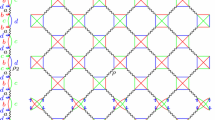Abstract
Edgeworth expansions for random walks on covering graphs with groups of polynomial volume growths are obtained under a few natural assumptions. The coefficients appearing in this expansion depend on not only geometric features of the underlying graphs but also the modified harmonic embedding of the graph into a certain nilpotent Lie group. Moreover, we apply the rate of convergence in Trotter’s approximation theorem to establish the Berry–Esseen-type bound for the random walks.
Similar content being viewed by others
References
Alexopoulos, G.: Convolution powers on discrete groups of polynomial volume growth. Can. Math. Soc. Conf. Proc. 21, 31–57 (1997)
Bentkus, V., Pap, G.: The accuracy of Gaussian approximations in nilpotent Lie groups. J. Theor. Probab. 9, 995–1017 (1996)
Bonfiglioli, A., Lanconelli, E., Uguzzoni, F.: Stratified Lie Groups and Potential Theory for their Sub-Laplacians. Springer Monographs in Mathematics. Springer, Berlin, Heidelberg, New York (2007)
Breuillard, E.: Local limit theorems and equidistribution of random walks on the Heisenberg group. Geom. Funct. Anal. 15(1), 35–82 (2005)
Campiti, M., Tacelli, C.: Rate of convergence in Trotter’s approximation theorem. Constr. Approx. 28, 333–341 (2008)
Folland, G.B., Stein, E.M.: Hardy Spaces on Homogeneous Spaces. Princeton University Press, Princeton (1982)
Gromov, M.: Groups of polynomial growth and expanding maps. IHES. Publ. Math. 53, 53–73 (1981)
Hough, R.: The local limit theorem on nilpotent Lie groups. Probab. Theory Relat. Fields 174, 761–786 (2019)
Götze, F.: On Edgeworth expansions in Banach spaces. Ann. Probab. 9, 852–859 (1981)
Götze, F., Hipp, C.: Asymptotic expansions in the central limit theorem under moment conditions. Z. Wahrsch. Verw. Geb. 42, 67–87 (1978)
Heyer, H.: Probability Measures on Locally Compact Groups. Springer, Berlin, Heidelberg, New York (1977)
Ishiwata, S.: A central limit theorem on a covering graph with a transformation group of polynomial growth. J. Math. Soc. Jpn. 55, 837–853 (2003)
Ishiwata, S.: A Berry–Esseen type theorem on nilpotent covering graphs. Can. J. Math. 56, 963–982 (2004)
Ishiwata, S., Kawabi, H., Kotani, M.: Long time asymptotics of non-symmetric random walks on crystal lattices. J. Funct. Anal. 272, 1553–1624 (2017)
Ishiwata, S., Kawabi, H., Namba, R.: Central limit theorems for non-symmetric random walks on nilpotent covering graphs: part I. Electron. J. Probab. 25 (2020), 46 pages
Ishiwata, S., Kawabi, H., Namba, R.: Central limit theorems for non-symmetric random walks on nilpotent covering graphs: part II. Potent. Anal. 55, 127–166 (2021). https://doi.org/10.1007/s11118-020-09851-7
Kotani, M., Sunada, T.: Albanese maps and off diagonal long time asymptotics for the heat kernel. Commun. Math. Phys. 209, 633–670 (2000)
Kotani, M., Sunada, T.: Standard realizations of crystal lattices via harmonic maps. Trans. Am. Math. Soc. 353, 1–20 (2000)
Kotani, M., Sunada, T.: Large deviation and the tangent cone at infinity of a crystal lattice. Math. Z. 254, 837–870 (2006)
Kumagai, T.: Random Walks on Disordered Media and their Scaling Limits, École d’Été de Probabilités de Saint-Flour XL-2010, LNM 2101. Springer, Cham (2014)
Kurtz, T.G.: Extensions of Trotter’s operator semigroup approximation theorems. J. Funct. Anal. 3, 354–375 (1969)
Malćev, A.I.: On a class of homogeneous spaces. Am. Math. Soc. Transl. 39, 276–307 (1951)
Namba, R.: Rate of convergence in Trotter’s approximation theorem and its applications, preprint (2020). arXiv:2011.13780
Pap, G.: Central limit theorems on stratified Lie groups, Probability theory and mathematical statistics, pp. 613–627. TEV, Vilnius (1994)
Pap, G.: Edgeworth expansions in nilpotent Lie groups. In: Probability Measures on Groups and Related Structures, vol. XI, pp. 274–291. Oberwolfach (1994)
Pap, G.: Uniqueness of embedding into a Gaussian semigroup on a nilpotent Lie group. Arch. Math. 62, 282–288 (1994)
Raugi, A.: Thèoréme de la limite centrale sur les groupes nilpotents. Z. Wahrsch. Verw. Geb. 43, 149–172 (1978)
Robinson, D.W.: Elliptic Operators and Lie Groups. Oxford Mathematical Mono-graphs. Oxford University Press, New York (1991)
Sunada, T.: Topological Crystallography with a View Towards Discrete Geometric Analysis, Surveys and Tutorials in the Applied Mathematical Sciences, vol. 6. Springer, Japan (2013)
Trotter, H.F.: Approximation of semi-groups of operators. Pac. J. Math. 8, 887–919 (1958)
Acknowledgements
The author would like to thank Professor Hiroshi Kawabi for providing valuable comments which make the present paper more readable. He also would like to thank an anonymous referee for reading his manuscript carefully and providing helpful comments. This work is supported by KAKENHI Grant No. 19K23410.
Author information
Authors and Affiliations
Corresponding author
Additional information
Publisher's Note
Springer Nature remains neutral with regard to jurisdictional claims in published maps and institutional affiliations.
Appendix A. Proof of Proposition 4.2
Appendix A. Proof of Proposition 4.2
We here give a proof of Proposition 4.2 in the case \(N=2\).
Proof of Proposition 4.2
Throughout the proof, \(\langle \cdot , \cdot \rangle _{\ell ^2(X_0)}\) and \(\Vert \cdot \Vert _{\ell ^2(X_0)}\) are abbreviated as \(\langle \cdot , \cdot \rangle \) and \(\Vert \cdot \Vert \), respectively. By virtue of the decomposition (4.1), we have
for \(n \in \mathbb {N}\) and \(x \in V_0\). In particular, the terms \(I_1, I_3, I_4\) and \(I_5\) are calculated as follows:
We note that the Perron–Frobenius theorem implies that there exists some \(\lambda \in (0, 1]\) such that \(\big \Vert \mathcal {L}|_{\ell ^2_{K_0}(X_0)}\big \Vert \le \lambda \). Hence, we see that
for \(f \in \ell _{K_0}^2(X_0)\). We now set
and
By noting (A.1), \(|\alpha _j|\le 1, \, j=1, 2, \dots , K_0-1\), and an inequality \(\Vert fg\Vert ^2 \le |V_0|\Vert f\Vert ^2\Vert g\Vert ^2\) for \(f, g \in \ell ^2(X_0)\), we conclude that \(\big \Vert A[f, g]_n^{(1)}\big \Vert =O(1)\) and \(\big \Vert A[f, g]_n^{(2)}\big \Vert =O(1)\) as \(n \rightarrow \infty \). This completes the proof of Proposition 4.2. \(\square \)
Rights and permissions
About this article
Cite this article
Namba, R. Edgeworth Expansions for Centered Random Walks on Covering Graphs of Polynomial Volume Growth. J Theor Probab 35, 1898–1938 (2022). https://doi.org/10.1007/s10959-021-01111-7
Received:
Revised:
Accepted:
Published:
Issue Date:
DOI: https://doi.org/10.1007/s10959-021-01111-7



